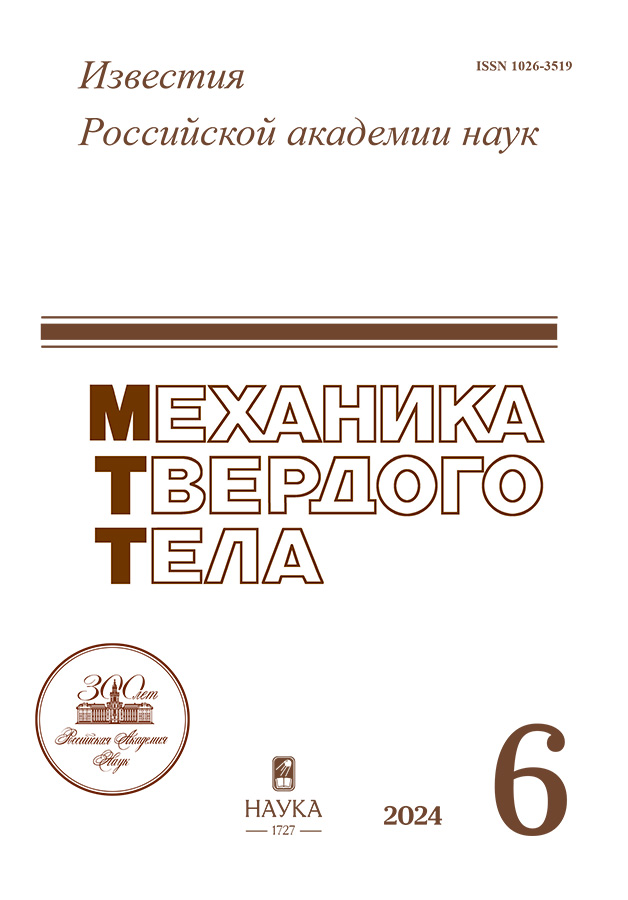Spatial vibrations of power transmission conductors with ice deposits
- Authors: Danilin А.N.1, Denisov E.A.2, Feldstein V.А.1,2
-
Affiliations:
- Institute of Applied Mechanics, Russian Academy of Sciences
- Moscow Institute of Physics and Technology (State University)
- Issue: No 6 (2024)
- Pages: 135-154
- Section: Articles
- URL: https://ruspoj.com/1026-3519/article/view/682275
- DOI: https://doi.org/10.31857/S1026351924060082
- EDN: https://elibrary.ru/TYZZZT
- ID: 682275
Cite item
Abstract
The problem of free spatial vibrations of an overhead power line wire with an asymmetric mass distribution over a cross-section caused by ice deposits on its surface, which give the cross-section an asymmetric shape, is considered. As a result, an eccentricity is formed between the centers of torsional stiffness and mass in the cross section and a dynamic connection of vertical, torsional and “pendulum” vibrations occurs with the output of the wire from the sagging plane. The wire is modeled by a flexible heavy elastic rod that resists only stretching and torsion. The case of a weakly sagging wire is investigated, when the tension and curvature of its centerline can be considered constant within the span. It is also believed that the elasticity of the ice casing is small compared to the elasticity of the wire. The mathematical model is constructed taking into account the interaction of longitudinal, torsional and transverse waves polarized in the vertical and horizontal planes. The relations of the phase velocities of all types of waves are analyzed and a group of particular subsystems determining partial oscillations is identified. The partial and natural frequencies and waveforms of the wire are studied. Analytical solutions to the problem of determining the spectrum of natural frequencies and forms of spatial vibrations are obtained. The effect of the ice casing on the vibration spectrum of the wire is studied. The dependence of the wave number of torsional vibrations on the frequency has been found, which is determined not only by the elastic-inertial, but also by the gravitational factor, which is strongly manifested for wires in long spans, especially those prone to Aeolian vibration (galloping). This circumstance is essential for the analysis of the Aeolian vibration phenomenon from the positions linking the occurrence of dancing by the convergence of the frequencies of torsional and transverse modes during the icing of the wire. It has been shown that the ratio of these frequencies, which cause an auto-oscillatory process, turns out to be significantly more complex.
Keywords
Full Text
About the authors
А. N. Danilin
Institute of Applied Mechanics, Russian Academy of Sciences
Author for correspondence.
Email: andanilin@yandex.ru
Russian Federation, Moscow
E. A. Denisov
Moscow Institute of Physics and Technology (State University)
Email: denisov.egor@phystech.edu
Russian Federation, Dolgoprudny
V. А. Feldstein
Institute of Applied Mechanics, Russian Academy of Sciences; Moscow Institute of Physics and Technology (State University)
Email: dinpro@mail.ru
Russian Federation, Moscow; Dolgoprudny
References
- Vibrations of overhead line conductors under the wind influence. Educational and reference manual. Part 1. Fatigue strength. Vibration / Ed. Vinogradov A.A.M.: Publishing house of JSC “Elektrosetstroyproekt”, 2005. 185 p.
- Yakovlev L.V. Conductor galloping on overhead power lines and ways to combat it. M.: NTF “Energoprogress”, “Energetik”, 2002. 96 p.
- Design of ultra-high voltage power lines / Ed. Alexandrov G.P. St. Petersburg: “Energoatomizdat”, 1993. 368 p.
- Zuopeng Wen, Haiwei Xu, Wenjuan Lou. Galloping stability criterion for a 3-DOF system considering aerodynamic stiffness and inertial coupling // Journal of Structural Engineering-ASCE, 2022, V.148, No.6: 04022048. doi: 10.1061/(ASCE)ST.1943-541X.0003328
- Wenjuan Lou, Dengguo Wu, Haiwei Xu, Jiang Yu. Galloping stability criterion for 3-DOF coupled motion of an ice-accreted conductor // Journal of Structural Engineering-ASCE, 2020, V.146, No.5: 04020071. doi: 10.1061/(ASCE)ST.1943-541X.0002601
- Haiwei Xu, Kunyang Ding, Guohui Shen, Hang Du, Yong Chen. Experimental investigation on wind-induced vibration of photovoltaic modules supported by suspension cables // Engineering Structures, 2024, V.299: 117125. doi: 10.1016/j.engstruct.2023.117125
- Danilin A.N., Onuchin E.S., Feldshteyn V.A. Model of thermomechanical vibrations of current-carrying conductors // Internwational Journal for Computational Civil and Structural Engineering. 2022. V.18. No.4. P.39–48. doi: 10.22337/2587-9618-2022-18-4-39-48
- Valiullin A.A., Danilin A.N., Feldshteyn V.A. Normal vibrations of sagging conductors of overhead power lines // International Journal for Computational Civil and Structural Engineering. 2022. V.18. No.3. P.147–158. doi: 10.22337/2587-9618-2022-18-3-147-158
- GOST 839-80. Non-insulated conductors for overhead power lines. Technical conditions.
- Vinogradov A.A., Danilin A.N., Rabinsky L.N. Deformation of multilayer spiral wire structures. Mathematical modeling, examples of use. M.: MAI Publishing House, 2014. 168 p.
- Dubois H., Lilien J.L., Dal Maso F. A new theory for frequencies computation of overhead lines bundle conductors // Rev. AIM. Liege. 1991. No.1. 168 p.
Supplementary files
















